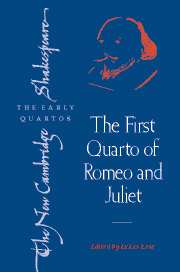Review of the hardback:'Readers who finished Shakespeare as a Literary Dramatist with the question 'now what?', puzzling what to do with a book whose fascinating implications would seem to return us to an older, author-centered mode of literary criticism, will be singularly impressed at how much Erne's Q1 Romeo and Juliet achieves toward seeing an old play with new eyes. … I take up Erne's edition of Romeo and Juliet as an exemplary attempt to move Shakespearean editorial theory beyond the problematising and iconoclazm that dominated the past two decades' repudiation of the New Bibliography. Erne leads us to reconsider the coherence of Q1 Romeo and Juliet as a play distinct from the one traditionally presented in modern editions.'
Source: Archiv
Review of the hardback:‘This is an excellent edition of a wonderful play. Lukas Erne’s annotations celebrate Q1 for what it is, rather than simply as an interesting adjunct to the received text. The challenging introduction, careful collations, insightful notes, and useful appendices open up the play to the wider audience it deserves …’
Source: Comparative Drama
Review of the hardback:‘Erne, whose book of 2003 (in the words of its title) repositioned Shakespeare as Literary Dramatist, has here valuably emphasized again the contrasting evidence for this and other plays’ equal connection to the dramatic and theatrical …’
Source: The Library
Review of the hardback:‘Erne offers a clear textual introduction, detailed commentary and helpful appendices … Erne’s edition is a worthy contribution to a fine series …’
Source: The Times Literary Supplement
Review of the hardback:‘The introduction does a masterful job of presenting all the theories and, without too obviously taking a side, puts the reader in possession of the relevant facts …’
Source: Notes and Queries
Review of the hardback:'His scrupulously annotated edition makes the full text of Q1 available for a general readership that can now readily compare the different versions of the play, and it provides excellent classroom material, for example, for in-depth courses on the Shakespearean text or on the first stagings of Shakespeare's plays.'
Source: English Studies



